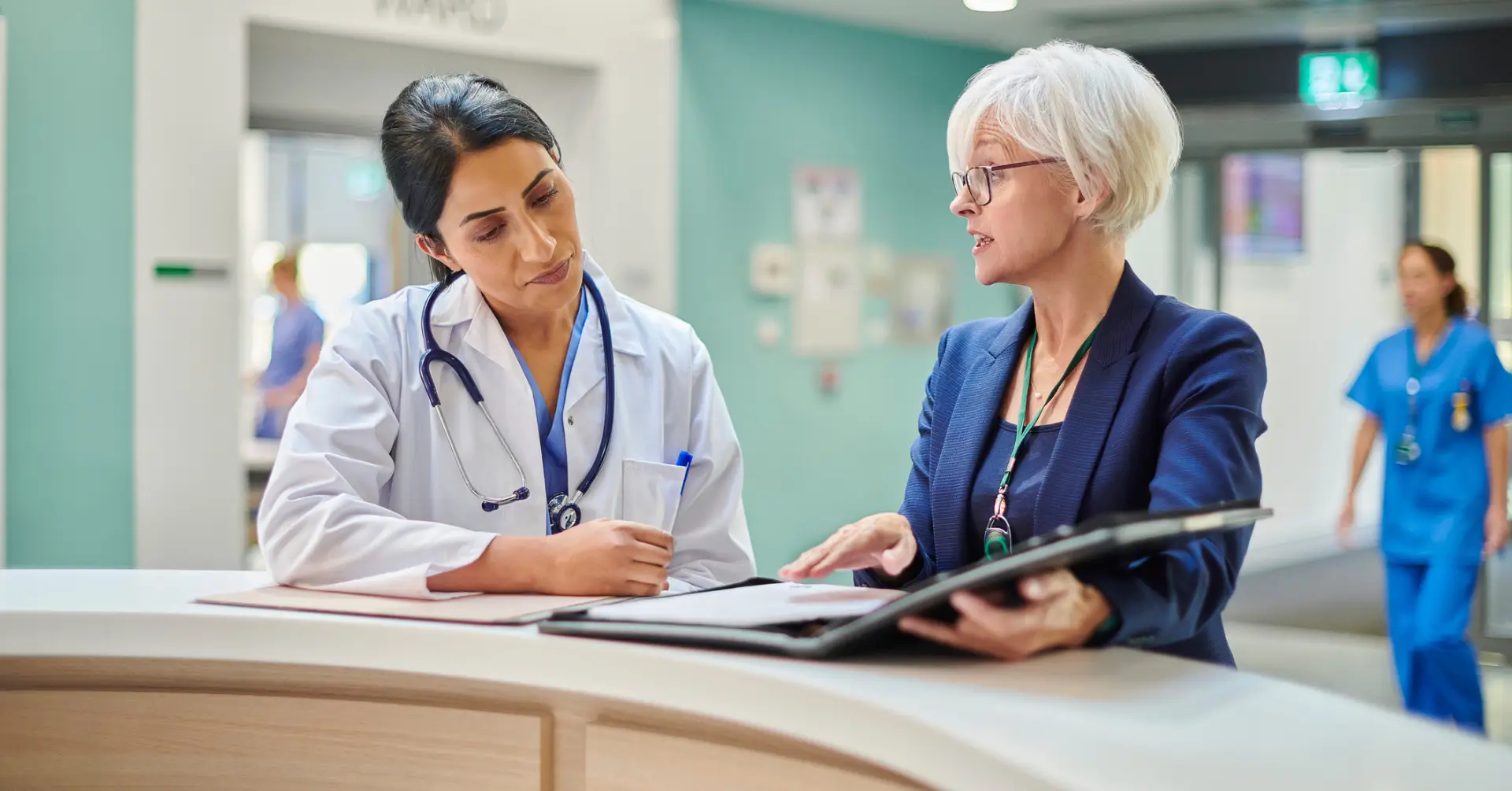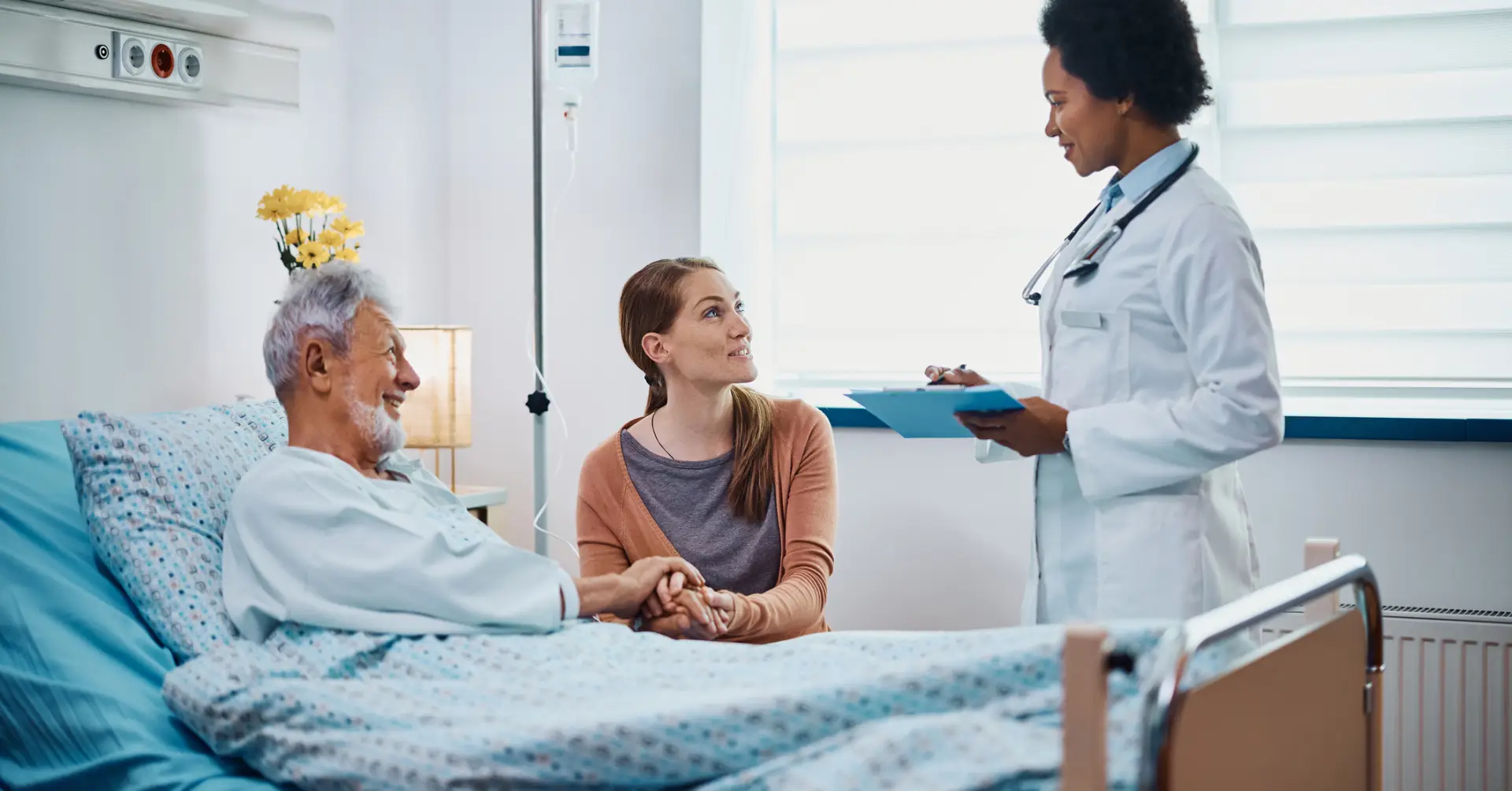Hospital-at-home programs bring hospital-level care into the home environment – creating positive outcomes and new experiences for many patients and clinicians.
There are three key components to most hospital-at-home programs:
- Brick and mortar hospitals that identify patients who may be eligible for hospital-at-home care
- Technology and logistics services that provide transportation, an in-home rapid response network, a patient-friendly home technology kit, and specially-trained and equipped in-home clinicians
- Remote clinicians and registered nurses that deliver round-the-clock, hospital-level care to patients in their homes
SCP Health partners with Medically Home, a hospital-at-home logistics coordinator, to offer a comprehensive solution for the second and third components of hospital-at-home care.
Leveraging deep clinical expertise, SCP Health has developed a dedicated clinical team based in a clinical command center that specializes in providing high-quality care to hospital-at-home patients. Stephen Nichols, MD, Chief of Virtual Clinical Services, and Cherl Phillips, MHA, BSN, RN, CEN, NE-BC, Clinical Director, Command Center came together for this expert Q&A to share learnings and best practices from SCP’s Virtual Clinical Command Center and how they relate to finding success in hospital-at-home care delivery.
Clinician Experience
What is the nurse experience like for hospital-at-home?
Cherl: Just like nurses who are caring for patients in the hospital, it is both intense and rewarding for the nurses in the Command Center. They have a full load of patients just like in the brick-and-mortar facilities while they are also collaborating with the service coordinators to fulfill ordering and in-home visits.
What we have found is that our nurses are certainly tired after their shift, but they are also incredibly fulfilled because of the meaningful connections they are making with patients and the impact they have on those patients’ lives.
What makes it different from standard inpatient nursing?
Cherl: Nurses are not able to do some of the things they typically would when in-person, so they have to develop new capabilities and behaviors which allow them to ensure high-quality patient care even though they are not physically in the room with the patient. The nurses rely on technology, and the use of their physical senses is limited.
When in person with a patient, nurses listen to heart, lung, and bowel sounds. They also palpate pulses and feel skin for temperature and moisture, and most experienced nurses can pick up clinical clues on their patients’ situation by smell as well, i.e., the odor of ketones in a patient with DKA.
The command center nurses have adapted and learned to utilize the in-home clinician as a substitute for their physical senses, as well as use their powers of observation in new and different ways. They are better able to recognize minute shifts in appearance, responsiveness, etc that may indicate how a patient is doing.
They have also learned to create a rapport with the patients through the video screen. While they are not in-person, they are able to see a different side of the patient – the pictures on the table next to them, the show that is playing on the TV, the people who are in the house. Those are clues to who the patient is as a person and their environment that are not always accessible in the hospital setting.
Nurses are also trained to think about preventing injury. The first thing the nurses said when we started training was, “What do we do if a patient falls”? In this program, we tackle this issue through assessing the patient’s environment and striving to mitigate the risks. The physicians must trust the primary in-home clinicians (PIHCs) for some aspects of the physical assessments of patients as well.
What is the physician experience like for hospital-at-home?
Dr. Nichols: Our physicians are very happy caring for hospital-at-home patients. At the end of the day, they want what is best for the patient, for them to be in the place that will best allow them to heal. We are finding that patients are often more comfortable being themselves in their homes, making physician-patient interactions more authentic and giving physicians a better idea of what interventions might work best for each individual patient.
What type of specialized training do physicians and nurses need to provide the best possible hospital-at-home care?
Dr. Nichols: The most important specialized training revolves around simulations with the entire team that accomplishes the care. We simulate different situations that involve the people who do go into the home, those who support the program from the individual hospital—pharmacy, laboratory, radiology, the clinicians from the admitting facility, and the consultants. Through these simulations, the team learns different workflows and protocols and builds rapport with the nurses in the Command Center.
Finally, the training provides time and repetitions with the technologies we use daily. We use a variation of see one, do one, teach one that goes more like see some, do some, everyone learns together. Our morning care team rounds are more involved but are very important for patient care and for progress with the program itself.
Cherl: Our nurses have the standard training required by the facilities and training in the technology and interfaces. The nurses complete additional lessons and simulations to help them be prepared to handle whatever might happen on a daily basis. We also have workflows and tip sheets that are available for the team for lower frequency, higher risk/stress events, such as a rapid response situation.
Additionally, we work with them on how to build rapport with the patients virtually, help patients with technology issues, and best communicate with the in-person care team members.
Patient Experience
How do patients benefit from a hospital-at-home program vs brick and mortar hospital admission?
Cherl: The patients get to rest. In the brick and mortar facility, patients are disturbed every hour or two, even at night, and it can be a very noisy environment. Our patients sleep in their own beds, with their own belongings next to them. This is a huge benefit. One patient was able to sit on her back porch and have her morning coffee just like always, and she loved taking the tablet and showing the care team her home. She said it was like making a bunch of new friends who happened to take care of her.
Dr. Nichols: We are seeing so many stories like that. We have unfortunately had someone pass away at home, which is a hard thing in any situation. However, in this case, the patient had been married for over 50 years and he was so happy to be at home instead of in the hospital. He spent his last night alive with his wife, who was very grateful, since had he been in a facility, the patient likely would still have passed away and his wife would have been home alone instead of being there with him. Those types of experiences are important too.
What are some concerns patients may have and how can you address them?
Cherl: Some patients have expressed concerns about how they would get help if they needed it in a hurry. We have a Patient Emergency Response System (PERS) device the patients wear and a PERS box. We test these with the patients twice a day to ensure they are functioning correctly. The average response time for all patient calls is less than 30 seconds, which is significantly faster than in most brick and mortar hospitals.
Dr. Nichols: Patients may be concerned about what happens if there is a shift in their condition and they need an increased level of care. This happens in the course of inpatient care– if a patient needs to go to the ICU or a telemetry unit, those care changes are easy to make whether you are admitted at home or in the hospital.
We have specialized criteria for hospital-at-home patients to ensure that we admit the right patients into the at-home program to make it less likely for those situations to happen. We also have plans in place for when we do need to adjust the level of care, so we are often able to alleviate those concerns.
What impact does having a specially trained clinical team have on the patient's experience of in-home hospital care?
Dr. Nichols: When a hospitalist who is practicing in a brick and mortar facility adds caring for hospital-at-home patients to their patient load, it can be hard for them to switch back and forth between the different types of patients. The way you think about interventions for at home patients is different because of the setting and logistics, and it’s not easy to do on the side, or at the end of a shift.
With a dedicated at-home team, we are not asking physicians to pivot their thinking in the middle of a shift. Dedicated hospital-at-home physicians also benefit from not losing time physically moving between rooms and across hospital floors and these seconds add up to more time the physician can spend with each patient. This extra time means the patient is more likely to develop a rapport and feel like the physician is focused on giving them individualized treatment.
Cherl: Dr. Nichols is absolutely right and that holds true for the nurses as well. I would also like to add that because the team is specially trained, they have troubleshooting capabilities for technology issues. The team also works closely with the boots on the ground clinicians, so the care is as seamless as possible.
Delivering High-Quality Care
What are the differences between brick and mortar inpatient care delivery and at-home inpatient care delivery?
Cherl: The main difference we have noticed is that everything takes additional planning and coordination. Everything the patient needs is brought to the home. However, we are purposefully trained for this and have a great partnership with Medically Home to enable this to occur.
Dr. Nichols: Cherl summed that up nicely. The additional planning and coordination are why it’s important for hospital-at-home physicians to be able to think differently about their treatments and interventions. They have to be a few steps ahead so they can thoughtfully order and prescribe what fits best with the logistics of patient care at home. All the extra thought pays off in patient experience.
How do you create a collaborative clinical environment for hospital-at-home programs?
Dr. Nichols: We have multiple huddles every day with the clinical team, to keep everyone on the same page and the process running smoothly. When everyone is in sync, it means the patient’s experience is more connected.
Cherl: The training process with three weeks of simulations has proven to be crucial in developing those relationships. The teams work collaboratively, and the primary in-home clinicians (PIHCs), physicians, and Command Center RNs are a team. I personally have met with my counterparts in person and have gotten to know many of the in-home clinicians with whom we work on a regular basis.
How do you create back-ups/contingency plans to ensure care is uninterrupted?
Cherl: At the Command Center, we have a backup generator in case we lose electricity in the building. The nurses’ laptops have battery power, and we also have portable routers in case the Wi-Fi goes down. In addition to these resources, there is also a backup contracted call line that will handle “rollover” calls that come in on the audio lines.
Dr. Nichols: In addition to all the physical backup and plans that Cherl mentioned, we have the ability to have physician backup available remotely. For the patient, the physician is remote whether they are in the Command Center or somewhere else, so the experience is seamless.
Interested in learning more about our hospital-at-home solutions?
Meet The Experts
Stephen Nichols, MD
Dr. Stephen Nichols is SCP Health’s Chief Clinical Innovation Officer and Chief Medical Officer for Virtual Clinical Services. He is a pragmatic realist with over 30 years of experience delivering acute care in a variety of settings and environments. His work for SCP Health focuses on helping organizations with various operational and service challenges by integrating services in effective and efficient ways, while maintaining the focus on the people we care for — patients and clinicians.
Dr. Nichols applies his down-to-earth style with a methodical approach to management that focuses on quality patient care while balancing provider expectations, client goals, and healthcare demands. His fundamental goal is to help organizations create spaces where employees enjoy working together and deliver the care they would want their families to have if they needed it. He combines the experiences reported to the organization with evidence from detailed data analytics to accomplish this goal.
Cherl Phillips, MHA, BSN, RN, CEN, NE-BC
With over 24 years of experience as an RN, Cherl Phillips is the Clinical Director Command Center for hospital-at-home. Having worked in various hospital settings throughout her career, including rural and community hospitals and larger urban facilities, Cherl is uniquely suited to the creativity and adaptability needed for hospital-at-home care. Previously she has worked as an emergency department supervisor and educator, managed the education department, started a dedicated observation unit, and was a director of acute and critical care at a facility in a large health system.
Along with her nursing degrees and certifications, Cherl holds a master’s degree in healthcare administration.






